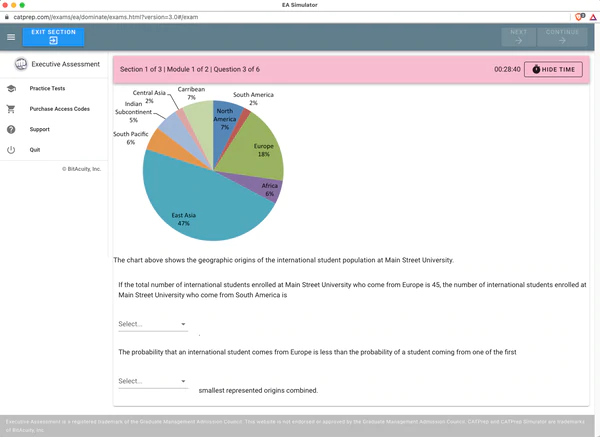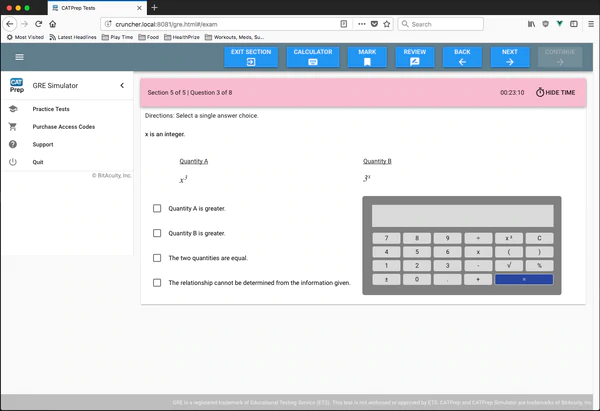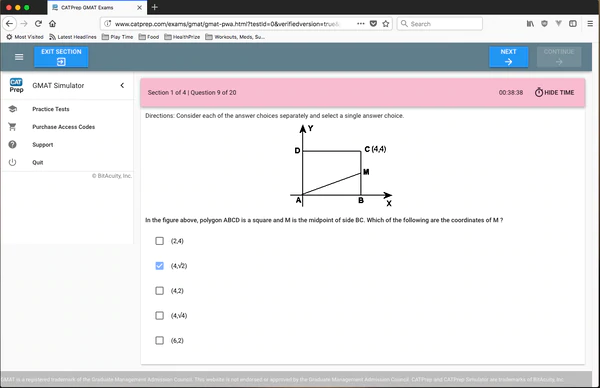GMAT Test Preparation
The Graduate Management Admission Test (GMAT) is, quite simply, an aptitude test. Aptitude tests of various kinds use different means of measuring both raw intellectual ability and acquired knowledge. The GMAT uses tests of English, logic and math skills to make its determination of candidates' aptitude for business school. Owned by the Graduate Management Admission Council and written with the aid of the Educational Testing Service (ETS), which administers the Scholastic Aptitude Test (SAT), the GMAT is used by almost 2000 business schools as part of the admissions process.
Unlike many standardized aptitude tests, the GMAT is not usually given in the old "pencil and paper" (P-P) format, although it can be. For the most part, you will take the GMAT as a computer-adaptive test (CAT) on computers. Although both the P-P and CAT format use the same kinds of questions, the medium through which they are presented can offer both advantages and disadvantages.
The biggest advantage of the CAT, certainly, is that you can take it at almost any time and is normally administered in a small group setting, whereas the P-P test typically takes place in large auditorium. However, in the CAT you cannot go back to reconsider previous questions, the computer screen is more susceptible to misreading than printed materials and it can be awkward to look up and down from the screen to one's scratch paper. Preparing for the test setting is an essential part of preparing for the GMAT or any other test.
Is the GMAT predictive?
The GMAT's success at predicting student performance is a subject of some controversy, as with the SAT. Some questions on the two tests are similar, despite being presented differently, although the GMAT includes two types of questions, 'Arguments" and 'Data Sufficiency," that are absent from the SAT. These kinds of questions present real problems to students who are unfamiliar with them, having never seen similar material in school. Adequate test preparation, of course, should remedy this situation.
Still, the question remains concerning both the GMAT's ability to predict scholastic success and the accuracy of its intelligence measurement. Clearly, no test has ever been devised that can measure every aspect of intelligence, since science is still discovering exactly what 'intelligence" is. Still, admissions tests of some kind are necessary to add balance to a seriously unbalanced set of criteria. Grades, for example, can be quite misleading, as in the case of a student earning A's in easy classes and another getting B's in quite challenging ones. Reputations of schools or school districts are also vague and imprecise indicators. Until some better idea comes along, tests like the GMAT are going to remain a rite of passage.
{include_file: {filename: src/emailLink.include , escape_html: false, process_output: true}}
Test format
The GMAT, as explained, will be administered as a CAT type of test most of the time, and takes three-and-a-half hours for four separate sections:
- Writing Section: Issue Essay (30 mins.)
- Writing Section: Argument Essay (30 mins.)
- Math Section: 37 Questions (75 mins.)
- Verbal Section: 41 Questions (75 mins.)
The GMAT begins with the writing sections, and you will use a very simple word processing program to type your essays. You have to answer each question before you can proceed to the next one, and you cannot return to any once you have moved ahead. The structure of the GMAT is inflexible and does not allow for deviation, since it is a standardized test.
Between (and behind) the lines
Every time it is given, the GMAT may present slightly different questions, but the difficulty level will be as close as it possibly can be to every other one. It is difficult to achieve this consistency, so the test designers use what are called 'experimental" questions, which are unscored. Because people approach problem solving differently, questions that end up on an actual, scored GMAT are first tested in this way, essentially to assess the relative difficulty they present. If the answers to an experimental question do not fit the scoring and assessment formula, that question will not be used on an actual GMAT.
Somewhere around one-fourth of GMAT questions are of the experimental variety, and can any type, from math and data sufficiency to arguments, sentence corrections and reading comprehension. Of course, you are never supposed to know which questions are the unscored, experimental ones, but if a questions seems comparatively more difficult or confusing than others, that may be an indicator. Then again, you have no way of knowing if the question is difficult or confusing for the other test takers, and thus should treat every question as being important.
Pace yourself to score well
Testing time is limited, of course, but you are advised not to hurry, as this will most certainly not help your eventual score. Because some problems contain nuances and subtleties, you must read carefully and completely. Having gone through (usually) four years of undergraduate studies before taking the GMAT, you may have developed some 'speed reading" practices that help you get 'the gist" of material without reading every word. This is not advisable in a testing situation of any kind, much less one that plays such an important part in your scholastic (and future) life.
The two major sections of the GMAT are scored separately, and you will get a verbal score from 0 to 60 as well as a math score in that same range. Your 'total score" will range from 200 to 800 (the average is 500), and your writing score ranges from 0 to 6. You will also get a percentile ranking. Percentile rankings tell you the percentage of students that had scores below your own.About Author:About The Author
{include_file: {filename: src/emailLink.include , escape_html: false, process_output: true}}


